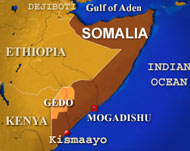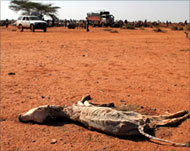Famine stalks Somalia again
Drought and lawlessness have devastated Somalia, and aid groups are struggling to get food and water to residents and livestock.

The UN Food and Agriculture Organisation’s Food and Security Analysis Unit (FSAU) says drought in the past two years has devastated agricultural production, causing aid groups to declare a famine in parts of the country.
At a feeding centre in northeastern Kenya, where desperate people from Southern Somalia cross to in the hope of getting some aid, young Somali mothers draped in colourful headscarves and bui bui (traditional head covering) nurse crying, malnourished children.
One mother, who brought her five-year-old to the clinic in Mandera district about a week earlier, says: “I am a housewife with not enough food or water for my children.
“Others at my home are also getting sick.”
Not enough food
Her child is suffering from diarrhoea, vomiting and fever, and she says she has been given antibiotics, anti-malarial medicines and special milk because she cannot breastfeed.
 |
|
Many Somalis cross over to |
“I have eight other children at my home in Bulla Nguvu. All of my family is affected by the drought because we don’t have enough meals for each day.
“We do receive food aid, but my family is large and farming is also a problem. We have lost many livestock.”
Each child brought to the feeding centre often has a host of diseases.
Prepare for worst
The government should prepare for the worst, an official for the UN food group says.
“Another failed rain, outbreak of conflict, and overflow of migration from Mogadishu of people already vulnerable to the outbreak of famine” could bring a humanitarian catastrophe, Nicholas Haan, chief technical adviser to FSAU, told Aljazeera.net.
“Agencies need to be preparing for that, and donors need to be prepping funds.”
Unicef Somalia’s emergency officer, Bob McCarthy, says his team is bringing water to drought-stricken areas.
“Our drought mobilisation went under way in January. We are making progress in terms of expanding access to water for human and livestock consumption.”
Sharing rations
Over half a million people are already receiving food aid in Somalia.
But USAID – which supplies the bulk of donated food to CARE Somalia – recently appealed for more funding and supplies for the country.
However, much of the food rations will be divided between people and their livestock.
 |
|
FSAU predicts 80% of livestock |
“People think of the long term,” says Abdul, a stock-keeper for the Gedo Health Consortium (GHC) clinic in Dolow, Somalia.
“They receive 2kg of beans, for example, and only half a kilogramme goes to the family while one and a half kg goes to the livestock.”
He points to two cows surviving from a herd that numbered 80.
“The family must keep them alive and share food rations, for hope of the future. The owners will not slaughter today because they would only have meat for two days,” Abdul says.
“If they can keep the primary livestock alive, they will have meat and milk throughout for one-two months.”
The FSAU predicts that 80% of all livestock in the Gedo region will be dead by April 2006.
Security problems
A large part of the problem in Somalia is that few aid groups are able to freely operate because of security concerns and the lack of a functional government.
There has been no central government in Somalia since a civil war broke out in 1991.
An interim parliament elected in 2005 convened in the country for the first time in February, but local militias still control two-thirds of the country.
 |
|
Regional and clan-based militias |
When humanitarian organisation CARE attempted its first food distribution in Garbaharey along the Ethiopian border in February 2000, its field officer, Said Ali Mumin, was attacked and shot.
Recounts Mumin: “We crossed over into Beled Hawa town from Kenya, just as we had done times before, for distributions to Beled Hawa and Luuk, and a group of men ran out from behind this building and opened fire on our vehicle.
“I was shot in the stomach, and the driver quickly turned back to the Kenyan side of the border.”
CARE decided not to pull its operations from the country, but authorised staff to hire militias to protect their convoys.
Unicef’s McCarthy, who was abducted and later released in March about 100km from Kismayo, says: “The operating environment in southern Somalia is very difficult for aid agencies.
“We have seen piracy of relief supplies, harassment and abduction of aid workers, and frequent conflict that has forced agencies to suspend operations for days or weeks at a time.
Haan, of the FSAU, says the onus is on Somali authorities to take charge of security issues.
Some progress
A Somali official says there has been progress and expressed hope that the situation is improving.
 |
|
The population is suffering from |
“Even though Somalia is still not considered safe, the TFG (transitional federal government) is making progress,” says Mohamed Ali Nur, commissioner for Somali affairs in Kenya.
“MPs are working closely with community elders to bring peace to regions so desperately in need of humanitarian assistance.
“We are optimistic to move forward with both the Arab League and the European Commission behind us,” he says.
But Abdifatah Abdullah Ahmed, resident of Dolow, Somalia, says: “It is obvious that the local people are having problems… Our livestock are dying in vast numbers and we are subsequently malnourished.
“The population as a whole, we are all suffering from malnutrition and the effects of the drought.”
* Pictures courtesy of WIR